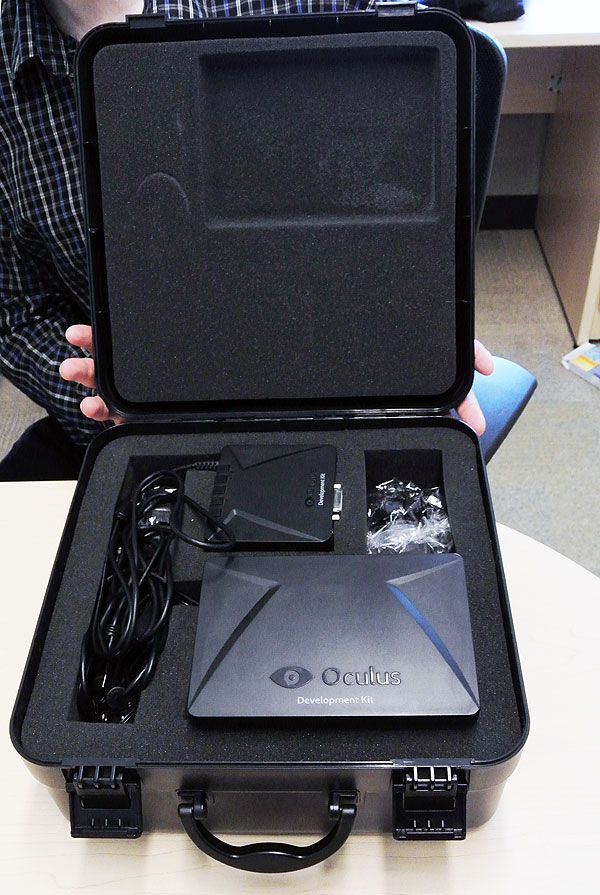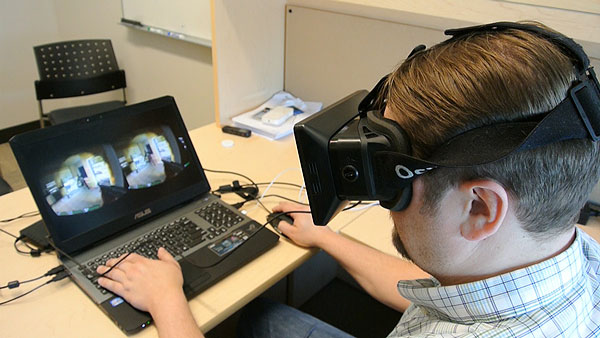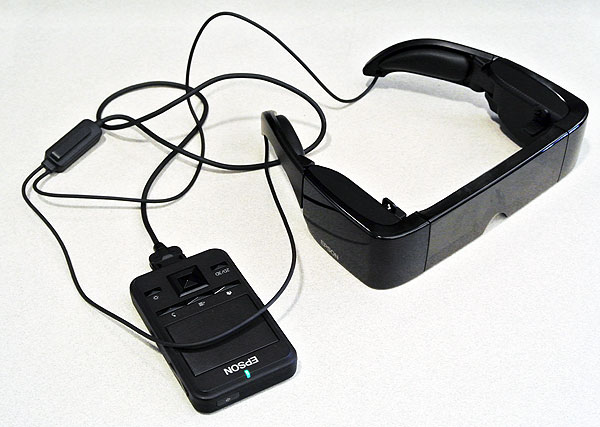3D, Virtual Reality, And Immersive Technology At The U Of OIT
Hardware: Cutting-Edge Immmersive Technologoies At UOIT
As an immersive technology enthusiast, the university visit was a great opportunity to examine some bleeding edge commercial and industrial products in the field:
The Oculus Rift Developer Kit
We've seen the Oculus Rift before, in January of this year at the Consumer Electronics Show in Las Vegas. The kits have been shipping for some time, and this trip was a great opportunity to see what the progressive company is delivering to developers and enthusiasts.
The first time we saw the Rift in action, we were blown away. Unfortunately, our time with the demo was short and we had spent a lot of it asking questions instead of experiencing the product.
In less of a rush, and given actual games to play (Skyrim and Left 4 Dead, thanks to the Vireio Perception drivers), we got a much better look at what the Rift development kit can and cannot do. It was a lot easier to be objective about the product's shortcomings this time around. Yes, the head tracking is still fantastic, and the field of vision is great. Having said that, ghosting issues remain a concern, especially in brightly-lit games with high contrast. It's much less of a problem in the dimly lit environments of Left 4 Dead.
We were also more aware of the relatively low resolution (1280x720 total, with each eye limited to 640x720) this time around. At this point, a 1080p display would be the minimum we'd want to see in a final consumer product. The good news is that Oculus has made it clear that the commercial release will support this. I was able to corner John Carmack at a recent event, and he said that Oculus is planning to release a Rift Dev Kit 2.0 with a 1080p screen and positional tracking, a feature the original model doesn't offer. The commercial version may have even better specifications.
Epson Moverio BT-100 Augmented Reality Glasses
If you listen to mainstream media, you might think that Google's Glass is the only augmented reality eyewear in development. Not so: Epson has been working on its Moverio BT-100 for years now. It's a very different product, though.
Instead of Google's comparatively inconspicuous offering with a single, tiny HUD over the user's right eye, Epson's solution provides two HUDs, each covering most of the area in front of the wearer's eyes. The Moverio takes the middle ground between the Oculus Rift and Google Glass. This makes virtual stereoscopic projection possible, and the potential applications are much more robust.
Get Tom's Hardware's best news and in-depth reviews, straight to your inbox.
For example, the following demo video showcases how the Moverio could help a technician disassemble machinery he's not familiar with:
That demo is a very impressive proof of concept system put together by Scope, an augmented reality company. But it's important to note that some specialized hardware and software is required, and not included with the Moverio, such as a head-mounted stereo camera.
Out of the box, Epson's solution is fairly limited. It runs on Android and can play video on what the user perceives as an 80-inch screen, with 480x540 pixel resolution per eye. At this point, the Moverio is more of a test mule for possible applications, and Epson is the first to admit that it's too bulky for the consumer market. But we applaud the company's dedication to R&D and hope a mainstream product will follow, someday.
The Cave Automatic Virtual Environment (CAVE):
CAVE stands for Cave Automatic Virtual Environment. It's a room that combines stereoscopic rendering technologies and motion tracking to deliver a seamless virtual 3D space. Short-throw projectors create images on two walls and a floor in a 6'x8' room with multiple cameras that observe the user. The projectors throw active 3D images rendered by the server, which uses Nvidia Quadro cards with genlock daugherboards. As the computer tracks your movement, the projection system adapts and changes the location and field of view. It's hard to describe, but the video below should give you a much better idea of its capabilities:
The university uses the CAVE for research, and the faculty claims that it's very good for Human-Machine Interaction work, or for working with a lot of data simultaneously. The commercial applications for a CAVE usually involve prototyping and architecture. Instead of imagining what things will look like from a blueprint, the CAVE allows engineers to digitally create the building, walk through it, and spot flaws or potential improvements before laying bricks and mortar.
While it's true that HMDs like the Oculus Rift can also help with this sort of task, a CAVE is uniquely able to deliver real-time perspectives based on the human head position in 3D space. Mind you, CAVEs are also a lot more expensive, which is why there are only a handful in Ontario. The CAVE is a great research and teaching tool, and it's wonderful to see students getting an opportunity to come up with new ways to use it.
Current page: Hardware: Cutting-Edge Immmersive Technologoies At UOIT
Prev Page Game Demonstrations Using Immersive Technologies Next Page The U Of OIT Has A Lot Of Cool Immersive Technology ResourcesDon Woligroski was a former senior hardware editor for Tom's Hardware. He has covered a wide range of PC hardware topics, including CPUs, GPUs, system building, and emerging technologies.
-
xkm1948 Hopefully the development of neuroscience will help sending signals directly to one's cortex without being processed by vision system. It is already doable in auditory system, although it is still indirectly stimulus of cortex. With a better understanding of cortex mapping, we may finally be able to get signals directly into brain without all the sensory organs!Reply -
clonazepam baby steps... baby steps. I dont see how that's possible without destroying healthy brain tissue during the learning process, so it'll never happen. Maybe some lab rats might get to enjoy some corridor run-throughs from the latest ID software, Quake 37 or something, but that's about it.Reply
I like the idea of several companies coming together to build a market to share with each other. That'd be nice. I've got a 3D Vision ready monitor and glasses. I messed around with it some when I first got it, but the quality of the experience from one game to the next was anything but consistent. Longer play sessions were interrupted by having to recharge the glasses too.
I'm still hopeful that we get there someday. It's nice to know there's a group of people out there to decide where "there" is, and help define it as we move toward it. -
piklar Bunch o Chickmagnets.... things will get interesting when Occy R goes retail , cant help but think they will be hard pressed to keep up with demand "how could you NOT want one?" exciting times ahead..Reply
-
bystander ReplyHopefully the development of neuroscience will help sending signals directly to one's cortex without being processed by vision system. It is already doable in auditory system, although it is still indirectly stimulus of cortex. With a better understanding of cortex mapping, we may finally be able to get signals directly into brain without all the sensory organs!
While that may be interesting, and very useful for the blind, part of the experience we have with 3D is processing it in the same manner we do in real life. Through our eyes.
I am a big fan of 3D Vision myself. I really wish all the poor versions of 3D never existed, so people would stop calling it bad or a gimmick, because in the right games, it is truly awesome. 3D Vision has a great mod community that fixes a lot of games too, using the Helix mod, for those into 3D, it is a must to use their mods. -
bnot "Back in 2007, 3D was in the hands of hardcore fringe enthusiasts, and reliable information was very had to come by." ?Reply
http://en.wikipedia.org/wiki/Virtuality_(gaming)
Virtuality is a line of virtual reality gaming machines produced by Virtuality Group, and found in video arcades in the early 1990s. The machines deliver real time (less than 50ms lag) gaming via a stereoscopic visor, joysticks, and networked units for multi-player gaming.
Initially introduced in 1991, the systems were developed for industry, where the first two networked systems were sold to British Telecom Research Laboratories to experiment with networked telepresence applications. Many other systems were sold to corporations including Ford, IBM, Mitsubishi and Olin. Professional virtual reality systems included the launch of the Ford Galaxy in virtual reality and a virtual trading floor for the London International Financial Futures and Options Exchange (LIFFE). However, the users' thrill of talking and mutually interacting with each other as virtual characters refocused the company's direction.....
http://www.cybermind.nl/Our%20Products/VR%20LBE%20Systems/visette_01.gif
-
Shankovich Wat UOIT is doing this stuff? LOL wow I should go visit. When I was applying to university 4 years ago they were offering insane entering scholarships because they were so new, $8000 a year if you had an average above 90%. Glad to see they're doing so well!Reply -
Verrin I went to UOIT for nuclear science. It's a neato school, the high costs of tuition is because you're renting a laptop with expensive software suites on it (cost is more for the software than the hardware). I sort of cringed everytime the author said "U of OIT". No one calls it thaaaaaat. It's UOIT.Reply


